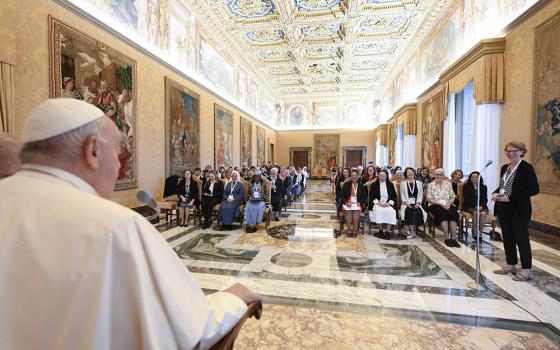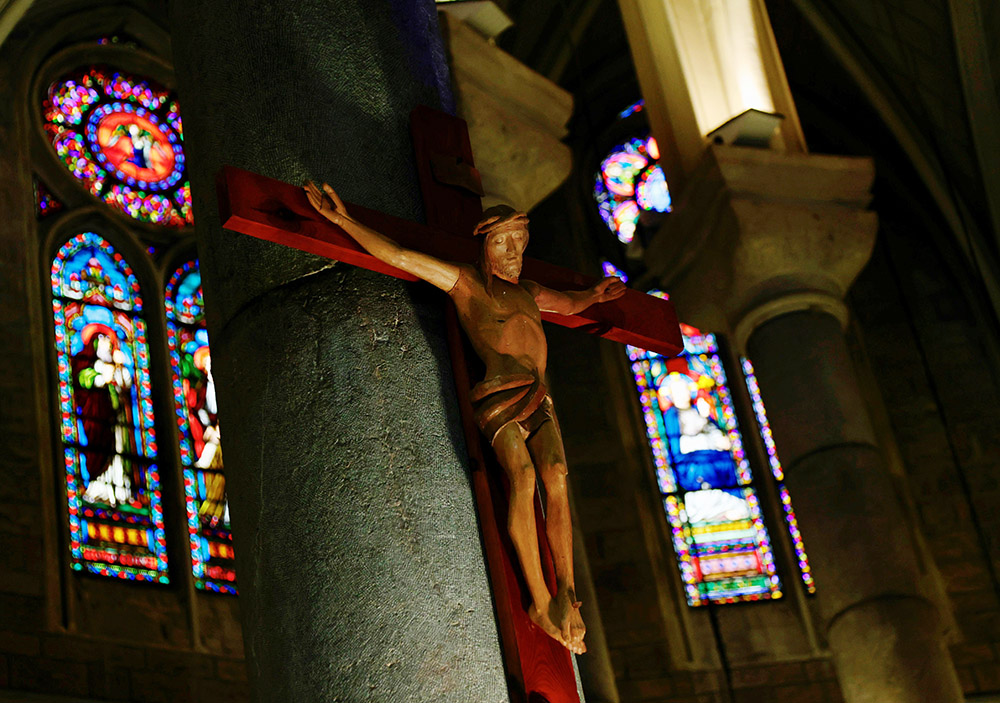
A crucifix is seen in Notre-Dame Basilica in Nice, France, Oct. 4, 2021. The next day, a report on clergy sexual abuse in the Catholic Church in France was released, showing there had been 3,000 abusers since the 1950s. (CNS/Reuters/Eric Gaillard)
It was in late spring, 1985, when I received a call from NCR's then-editor Tom Fox. I think he said he hoped I was sitting down.
Fox and I often exchanged calls when we thought that one of our publications had something of interest for the other. At the time, I was news editor of what was then called Religious News Service, headquartered on a floor in the former Jesuit residence at 56th Street and Sixth Avenue in New York.
I was sitting at my desk when he told me that NCR's next edition would contain an extensive and rather explosive report detailing the abuse of children by Catholic priests and the failure of hierarchy to do anything about it.
That conversation was a jarring introduction to corruption and evil that continue to reverberate to this day. That first national story to be published about the scandal was extensive, detailed, and the accompanying editors' commentary saw far into the future.
Members of the hierarchy appear not to realize the depth to which the effects of the scandal have seeped into every level of the institution. If they did, they would be acting far differently.
What I eventually came to understand about the scandal affected not only my career (I landed at NCR in 1994) and how I would spend my time in the world of religion reporting. It would also ultimately place in question much of what I knew and understood about the church.
What transpired regarding the scandal in the more than 35 years since that phone conversation continues to be the dominant lens through which I view developments in the church, including the synodal process underway. I agree with theologian Massimo Faggioli and Jesuit Fr. Hans Zollner, who wrote recently in this space: "It must be understood that the chances of the synodal process that will soon begin its continental phase are closely tied to what the Catholic Church is doing and not doing on the abuse crisis. It's about the abuse crisis even when it's not explicitly about the abuse crisis."
Members of the hierarchy (there are exceptions, but they are few) appear not to realize the depth to which the effects of the scandal have seeped into every level of the institution. If they did, they would be acting far differently. They resemble addicts, clinging to old perks and privileges of a secretive culture, as well as to former notions of superiority and a magically acquired otherness.
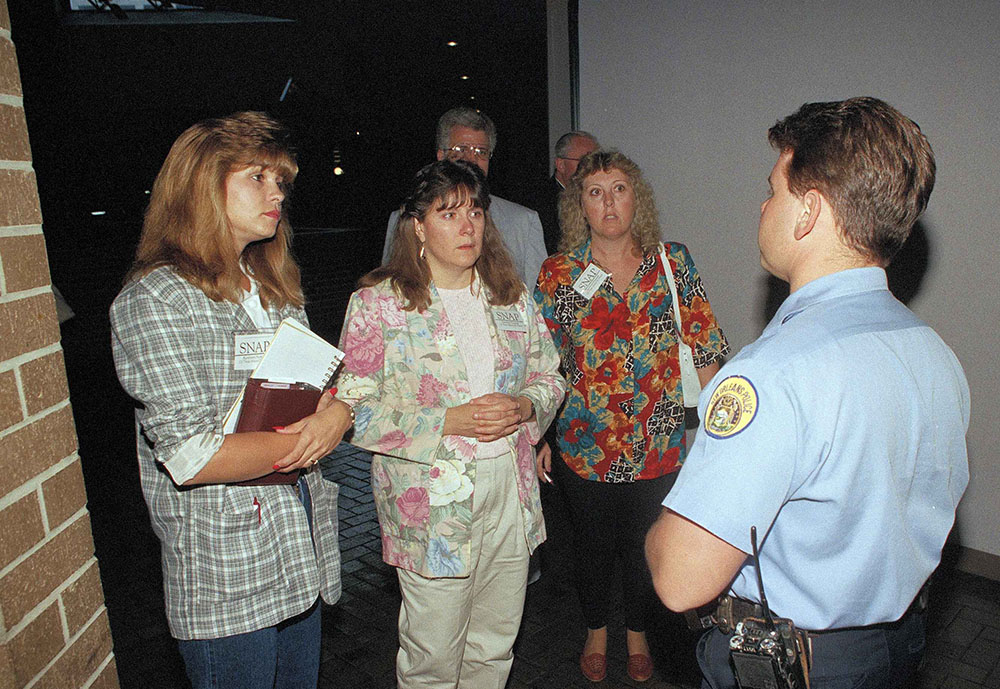
A New Orleans police officer stops, from left, Mary Staggs, Barbara Blaine and Sandy Graves from entering the National Conference of Catholic Bishops meeting in New Orleans on June 17, 1993. The women were members of the Survivors' Network for Those Sexually Abused by Priests, or SNAP. (AP/Paul Sancya)
They seem incapable of understanding the destruction they've wrought and the profound breach of trust that has estranged them from the people of God. The hierarchical culture seems unable, as a collective body, to see outside of itself.
Effects of abuse
After retiring from more than 35 years of religion journalism, the bulk of it at NCR and dealing with Catholic Church issues, I began to sort and cull old files. In one of those sessions my wife, Sally, happened by and picked up one of the files. It contained the details of a priest pedophile from long ago. After about 10 minutes of reading through it she called to me, a look of curiosity and disgust on her face, and asked, "How did you deal with this for so many years?"
My immediate and automatic reply was to mumble some journalism boilerplate, not untrue but hardly adequate to the question of the moment.
The question would not recede, however, and the more authentic answer evolved. I pondered the question with all of my professional guardrails down, with no need to exercise the discipline of journalistic distance, or with the responsibility to turn the prism just one more degree to be certain no element of complexity was missed.
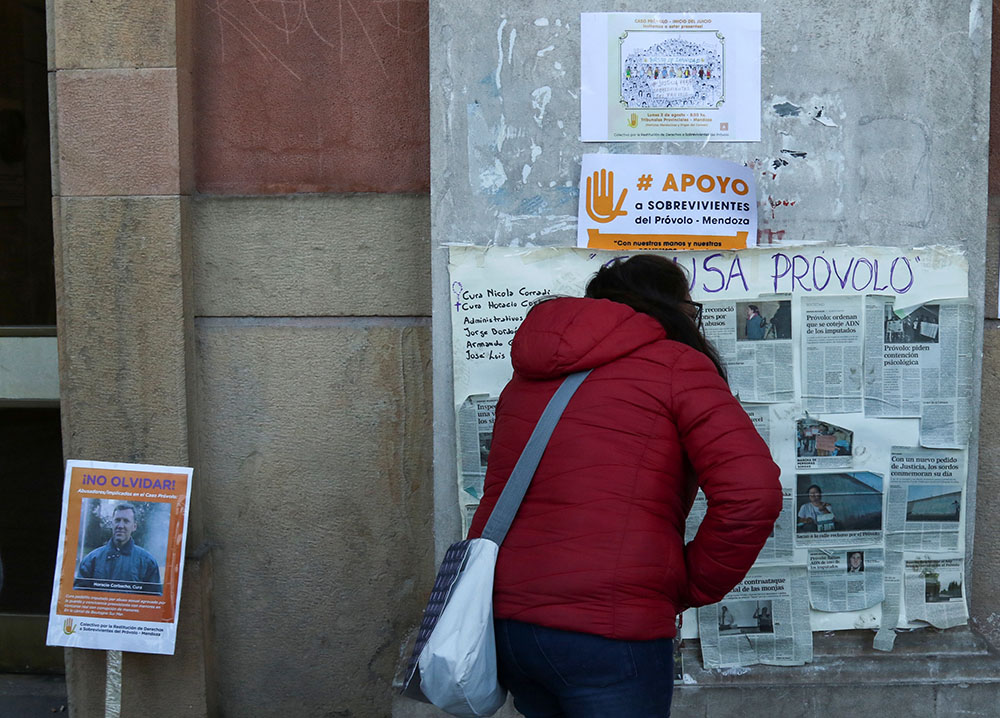
A woman reads a sign outside a courthouse Aug. 5, 2019, during the beginning of the trial of Catholic priests and a school employee, who were later convicted of sexual abuse that took place between 2004 and 2016 at the Antonio Provolo School for Deaf and Hearing Impaired Children in Mendoza, Argentina. (CNS/Reuters)
I realized that I was one of a very small cadre of people on the planet whose work had required us to spend enormous amounts of time, unplanned for and certainly unexpected in the pursuit of religion journalism, to read through endless files of investigations, grand jury reports, depositions and the maddening bishops' correspondence.
One moment that contains the concentrated evil of the scandal will never be erased from my memory. It occurred in New Orleans the night before I covered a conference of the Survivors Network of those Abused by Priests (SNAP). I was with Jason Berry, whose reporting was foundational to that original exposé in NCR. We attended an outdoor service on a chilly January evening in 2004 conducted in a public park. It was a memorial, attended mostly by family members, for a group of about 50 victims of clergy sexual abuse. The thread that bound the somber gathering was that all of the victims had died by suicide, most when they were in their 20s or 30s.
A psychologist priest once advised me to move away from the scandal for my own good. It would have been ethically unconscionable to do so, knowing what I then knew.
In my retirement, I was left facing the same stark truth: I know what I know. I can't unknow it.
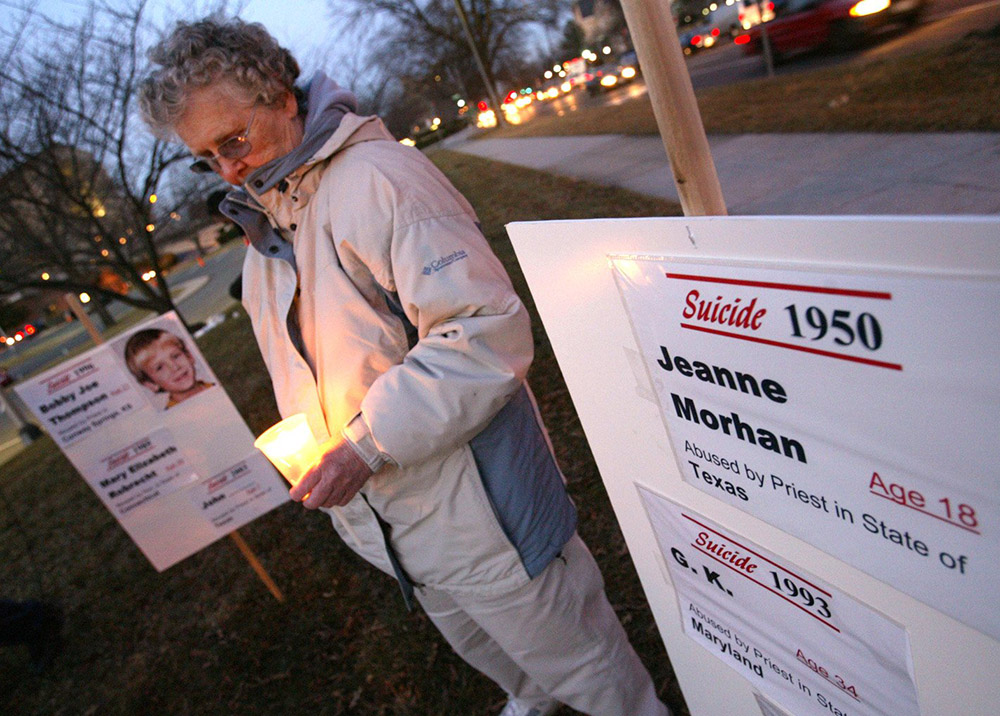
Zoe Carpenter of Germantown, Maryland, listens as the names of those who had been sexually abused by clergy and who later died by suicide are read during a candlelight vigil outside the Catholic University of America in Washington, D.C., Feb. 27, 2004. (CNS/Nancy Wiechec)
Over all those years, some things did change. The bishops reluctantly acknowledged that they were in crisis. They established mechanisms for accountability. But I think it is not a stretch to say that almost all, if not all, of the institutional adjustments, new laws and grudging acknowledgements were not the result of transformation or sacramental imagination. They were the result, instead, of outside forces, primary among them an often-vilified press and legal procedures.
I also came to understand in those years that the abuse in the Catholic community was different, horrible as any abuse is, from abuse that occurred in other contexts.
Sacramentality
In his massive work Catholicism, the late theologian Fr. Richard McBrien, in describing "sacramentality" beyond the classic definition of sacrament, quotes Pope Paul VI's address before the second session of Vatican II. The pope, he writes, "provided a more contemporary definition: 'a reality imbued with the hidden presence of God.' "
The Catholic world has what McBrien described as "a sacramental perspective" that "'sees' the divine in the human, the infinite in the finite, the spiritual in the material, the transcendent in the immanent, the eternal in the historical. For Catholicism, therefore, all reality is sacred."
Advertisement
Catholics understand McBrien's point. In fact, the point was exaggerated in past decades. Regular churchgoers regarded the priest as something other, ontologically different, invested with mysterious powers and high standing. He was able to do what no other humans could do — confect the Eucharist — thus allowing the faithful access to what the catechism terms the "source and summit" of life in the church.
The abuse crisis itself has highlighted the deficiencies of such theology, but sacramentality has not evaporated from the Catholic community.
Catholics see things — the world, each other, the source and purpose of life — differently. Thus, it seems inescapable to conclude that abuse of children by priests has layered upon it additional dimensions not present in other circumstances. It is a violation of "sacred reality."
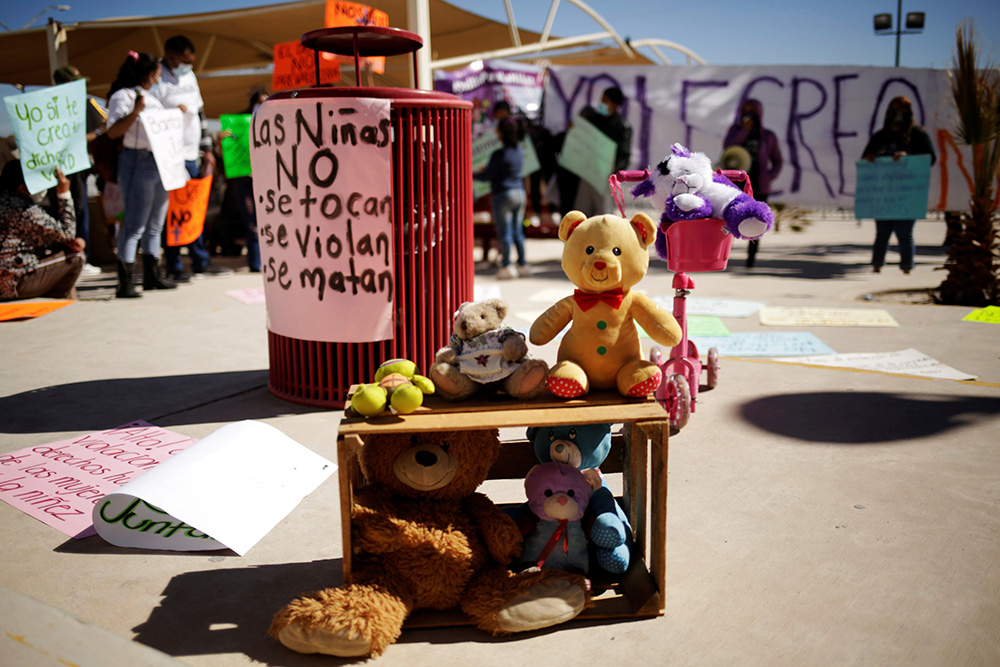
Children's toys are seen during a protest to demand justice against a Catholic priest accused of sexually abusing a minor, outside the courts in Ciudad Juárez, Mexico, Feb. 22, 2021. (CNS/Reuters/Jose Luis Gonzalez)
The protections and sanctions put in place by the church as a result of the scandal are indistinguishable from those expected of any secular organization. Abuse by priests and the hierarchical cover-up, however, were a breach of trust, an unprecedented betrayal, at a sacramental level.
Faggioli and Zollner, a member of the Pontifical Commission for the Protection of Minors, understand the profound effect the scandal has had on the church and the necessity to include it in all of the synodal discussions. The synodal process underway, they write, "cannot be understood outside of the epoch-changing abuse crisis in the Catholic Church." The drain of authority and credibility from the episcopacy and the drain of people from the pews is proof enough of that point.
Some may argue that the worst of the cardinal and bishop offenders are either retired or dead. But anyone familiar with our ancient wisdom knows that is an empty defense. The betrayal doesn't retire or go to the grave with them. I would dare to attest for millions that the unrepented past doesn't just go away. Reconciliation and forgiveness can't be enforced by edict; they are not passive activities.
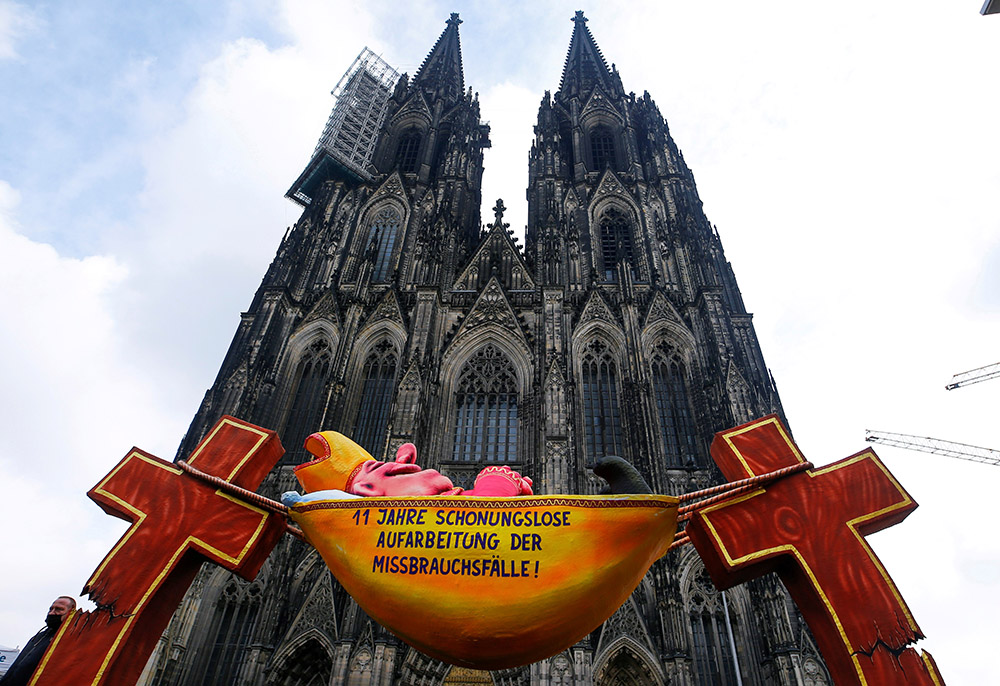
A carnival float showing an unnamed bishop is placed in front of the Catholic cathedral by activists protesting sexual abuse by priests in Cologne, Germany, March 18, 2021. The wording on the float reads "11 years of brutal honest reconnaissance of sexual abuse." (CNS/Reuters/Thilo Schmuelgen)
"Reform of the church," Faggioli and Zollner maintain, is the issue over which many more will decide whether to join the legions who have already left or to stay.
But what does reform of the church mean?
The missing element
Sacramental life is about far more than changes in structures, rules and administrative categories. It is about transformed hearts.
The hierarchical culture, for better or worse — and regardless of how much input is permitted from laypeople — will in the end decide how synodality is integrated into the life of the church.
If that culture is not reformed at its core — and that means transformation of individuals — then little else matters. What can synodality mean when there's been such a deep, sacramental betrayal? How can it possibly work?
Woefully absent from the synod on synodality is what has also been missing from the endless analysis of the crisis: what the bishops themselves need to do beyond institutional adjustments.
I know well the goodness of the church, the heroic goodness of many of its members and leaders. I've written at length about such examples. I am not opposed to institutional Catholicism. Institutions are essential, but it is just as essential to understand when they are in peril. Indeed, it is the institution's deepest and richest traditions that contain the remedy to the institution's crisis.
Woefully absent from the synod on synodality is what has also been missing from the endless analysis of the crisis: what the bishops themselves need to do beyond institutional adjustments.
The synodal process should include a layer of discussion exclusive to the hierarchy. The discussion should engage the ecclesial equivalent of a 12-step program, pulling from the deepest wells of our sacramental tradition: an examination of personal and corporate actions of the past, an honest naming of the corporate and individual sins of past decades.
And please, no apologies for "mistakes made," or glib throwaways like "hindsight is always 20/20." The faithful have endured decades of such insults; we know far more than you might suspect.

Children's shoes and toys are seen on a sidewalk in Dublin Aug. 25, 2018, as part of a demonstration against clerical sex abuse in the archdiocese. (CNS/Reuters/Clodagh Kilcoyne)
Zollner made the point in a January interview with RNS: He urged bishops and faithful to " 'do publicly what they do privately when they go to confession,' listing the steps necessary for the sacrament — examination of conscience, honest repentance, clear confession and the attempt for reparation," RNS reported.
"Then you can get forgiveness and absolution," Zollner said.
I offer a question that might focus such an examination of conscience: What would you, members of the hierarchy, require of a group of powerful laypeople who had conspired to engage in the worst public betrayal of the church in modern history, smeared the name of Catholicism globally in an unprecedented way, done unspeakable violence repeatedly to the most vulnerable, engaged in elaborate strategies to conceal the sin, drained the church of credibility in much of the world, raided its treasury to pay for silence, and now wished everyone would just move on?
What do you do to reconcile with the community when you've been complicit in what one longtime victims' advocate termed "soul murder"?
Ponder that, bishops and cardinals, and let us know what you come up with. Without your answer, the corrosive effect of scandal proceeds and synodality is an empty exercise.






